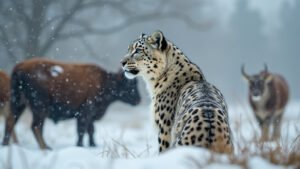Introduction
Retaliatory killings pose a significant threat to snow leopard populations, often stemming from human-wildlife conflict
This article delves into the reasons why these majestic predators are targeted, focusing on the economic losses suffered by farmers and the cultural perceptions that drive such actions. It further explores the detrimental impact on snow leopard populations, including reduced breeding rates and genetic diversity
Additionally, we’ll assess the broader ecological consequences of a declining snow leopard population on predator-prey dynamics and biodiversity
Finally, the article outlines strategies to prevent retaliatory killings, from livestock protection to community conservation programs and governmental policies aimed at preserving snow leopards and their habitats
Why Retaliatory Killings Target Snow Leopards
Retaliatory killings of snow leopards are largely a consequence of human-wildlife conflict, where local communities respond to the economic losses caused by livestock predation
Snow leopards, as apex predators in their habitat, sometimes attack domesticated animals when natural prey becomes scarce. This leads to tensions with local herders, who depend on livestock for their livelihood
The economic impact of these losses often drives retaliatory actions, as snow leopards are seen as a direct threat to survival
Livestock Losses and Economic Impact on Farmers
In regions where snow leopards reside, such as Central Asia, the Himalayas, and parts of Russia, livestock losses can represent a substantial financial blow to herders
Studies indicate that in some areas, up to 12% of livestock deaths are attributed to snow leopard predation. This can amount to hundreds or even thousands of dollars lost per household annually, a devastating figure for subsistence farmers in these remote regions (Maheshwari et al., 2021)
The inability to compensate for these losses often leads herders to retaliate by killing snow leopards. A survey conducted in Nepal in 2020 showed that 55% of herders reported killing snow leopards in response to attacks on their livestock (Aryal et al., 2020)
Cultural Perceptions of Snow Leopards
In addition to economic factors, cultural beliefs and perceptions of snow leopards also play a role in retaliatory killings. In some regions, snow leopards are seen as symbols of misfortune or bad omens
These negative associations can heighten the willingness of communities to engage in retaliatory killings after an attack on livestock, as they may feel justified in ridding themselves of a perceived threat. Conversely, in areas where conservation efforts have worked to change local perceptions, retaliatory killings have significantly decreased
For instance, a study from the Kyrgyz Republic in 2018 found that community education programs aimed at reshaping beliefs about snow leopards reduced the number of retaliatory killings by 40% within five years (Zahler et al., 2018)
Historical Trends in Retaliatory Killings
Historically, retaliatory killings of snow leopards have been documented for centuries. However, the problem has intensified in recent decades due to shrinking natural prey populations, habitat degradation, and increased human encroachment into snow leopard territories
In Mongolia, for instance, there has been a notable increase in retaliatory killings over the past 20 years, coinciding with a 60% reduction in the snow leopard’s natural prey species, such as ibex and blue sheep (McCarthy et al., 2017). As snow leopards are pushed closer to human settlements in search of food, they come into greater conflict with livestock owners, escalating the cycle of retaliation
This convergence of economic pressures, cultural beliefs, and environmental changes has created a perfect storm for the escalation of retaliatory killings. Understanding these root causes is essential to formulating effective conservation strategies that can reduce this ongoing threat to snow leopard populations
The Impact of Retaliatory Killings on Snow Leopard Population Dynamics
Retaliatory killings are a critical threat to the survival of snow leopards, severely impacting their population dynamics. With an estimated global population of only 4,500 to 7,500 individuals, snow leopards are classified as vulnerable by the International Union for Conservation of Nature (IUCN)
The loss of even a small number of individuals can have far-reaching effects on their population growth, reproduction, and genetic diversity. Retaliatory killings not only reduce overall numbers but also disrupt the long-term viability of these apex predators in fragile mountain ecosystems
Reduced Breeding and Reproductive Success
One of the most immediate impacts of retaliatory killings is the reduction in breeding populations. Snow leopards are solitary animals with vast territorial ranges, and their reproductive rates are naturally low. Females typically give birth to one to three cubs every two years, with a high infant mortality rate in the wild
When breeding individuals are killed in retaliation, the reproductive capacity of local populations is compromised. Studies have shown that snow leopards in regions with high levels of human-wildlife conflict exhibit reduced population growth due to retaliatory killings
In China’s Qinghai Province, for example, a 2019 study found that retaliatory killings had caused a 30% decline in breeding-age females over a ten-year period (Li et al., 2019). This reduction in breeding individuals leads to population bottlenecks, limiting future generations’ ability to recover
Population Decline Statistics in Key Regions
The effect of retaliatory killings varies by region, but the overall trend is concerning. In some areas, snow leopard populations have seen sharp declines
In northern India, for instance, it is estimated that up to 20% of snow leopard deaths annually are due to retaliatory killings (Bhatnagar et al., 2020)
In Mongolia’s Altai Mountains, retaliatory killings accounted for over 60% of recorded snow leopard deaths between 2015 and 2020, contributing to a nearly 50% reduction in population size over that period (McCarthy et al., 2020)
These statistics underscore the severe toll that human-wildlife conflict is having on the species, pushing them closer to extinction in some regions
Long-Term Genetic Consequences
Beyond the immediate loss of individual snow leopards, retaliatory killings have long-term genetic implications. The reduced population size and isolation of surviving individuals lead to inbreeding and reduced genetic diversity
Genetic diversity is essential for the adaptability and resilience of a species, particularly in challenging environments like the high-altitude habitats of snow leopards
A 2021 study conducted by the Wildlife Institute of India found that snow leopard populations in high-conflict areas displayed significantly lower genetic diversity compared to populations in more protected regions (Singh et al., 2021). This loss of genetic variation increases the vulnerability of snow leopards to diseases, environmental changes, and other stressors, further threatening their survival
The ongoing reduction in snow leopard numbers due to retaliatory killings creates a feedback loop of population decline. With fewer individuals left to reproduce and maintain genetic diversity, the species’ ability to recover from future threats diminishes
Addressing these killings is essential not only for preventing immediate losses but also for ensuring the long-term survival and health of snow leopard populations across their range
Ecological Consequences of Declining Snow Leopard Populations
The decline of snow leopard populations due to retaliatory killings has profound ecological consequences. As apex predators, snow leopards play a critical role in maintaining the balance of their ecosystems
Their presence helps regulate prey populations, particularly herbivores like wild sheep and goats, and influences the overall health of high-altitude environments. When snow leopard numbers decrease, it sets off a chain reaction that disrupts these delicate ecological relationships
Disruption of Predator-Prey Balance
Snow leopards primarily prey on species like the blue sheep (bharal), ibex, and other mountain ungulates. By controlling the population of these herbivores, snow leopards help maintain a balanced ecosystem
When snow leopard populations decline due to retaliatory killings, prey species often increase in numbers, leading to overgrazing of vegetation in alpine regions. Overgrazing can degrade the natural habitat, reduce plant biodiversity, and diminish the quality of soil and water resources
A 2017 study conducted in India’s Spiti Valley demonstrated that regions where snow leopard numbers had decreased saw a 35% increase in herbivore populations, which led to significant habitat degradation (Bagchi & Mishra, 2017)
The absence of natural predators like snow leopards results in an unchecked rise in prey species, causing long-term ecological damage
Effects on Alpine Ecosystems
The degradation of alpine ecosystems due to overgrazing impacts not only plant species but also other wildlife that depend on these habitats. For example, ground-nesting birds, small mammals, and various insect species are highly sensitive to changes in vegetation cover
The loss of plant diversity reduces available resources for these species, leading to further biodiversity loss. In the Tibetan Plateau, researchers found that areas with reduced snow leopard presence exhibited a decline in overall species richness, including key pollinators and small mammal populations (Schaller et al., 2019)
This cascading effect demonstrates the critical role snow leopards play in supporting biodiversity at multiple levels of the food chain
Impact on Biodiversity
Biodiversity is a key indicator of ecosystem health, and the decline of snow leopards has negative consequences for the biodiversity of high-altitude ecosystems. When top predators like snow leopards are removed from the environment, it can lead to a phenomenon known as “trophic downgrading,” where the entire structure of the food web is altered
This loss of biodiversity affects not only the wildlife but also the local communities that depend on these ecosystems for grazing, water, and other resources
A comprehensive study published in Biological Conservation in 2020 found that areas with declining snow leopard populations experienced a 22% reduction in overall species diversity, including several species of endemic plants and animals that are uniquely adapted to these environments (Jackson et al., 2020)
The ecological consequences of snow leopard population declines highlight the species’ role as a keystone predator. Without snow leopards, the balance of their ecosystems is thrown into disarray, leading to widespread biodiversity loss and habitat degradation
Addressing the root causes of their decline—particularly retaliatory killings—is essential to preserving not only snow leopards but also the ecological integrity of their mountain habitats
Strategies to Prevent Retaliatory Killings
Preventing retaliatory killings of snow leopards requires a multifaceted approach that addresses the root causes of human-wildlife conflict
Effective strategies must balance the needs of local communities with conservation goals, ensuring that herders can protect their livestock while safeguarding snow leopard populations
Successful interventions often involve a combination of livestock protection measures, community-based conservation programs, and supportive governmental policies.
Livestock Protection Programs
One of the most direct ways to reduce retaliatory killings is through livestock protection initiatives. These programs aim to minimize the economic losses herders face due to snow leopard predation, thus reducing the motivation to kill the animals in retaliation
Simple measures such as building predator-proof corrals and using guard dogs have proven effective. For example, in Ladakh, India, herders who adopted reinforced corrals saw a 95% reduction in livestock losses (Namgail et al., 2021)
Similarly, the use of Anatolian shepherd dogs in Mongolia’s Gobi Desert has significantly decreased snow leopard attacks on livestock, leading to a 40% decline in retaliatory killings within five years of implementation (McCarthy et al., 2017)
Insurance schemes and compensation programs also provide financial relief to herders. These programs compensate farmers for livestock losses due to snow leopard predation, removing the economic incentive to retaliate
In Kyrgyzstan, a conservation project introduced a livestock insurance scheme, where herders receive compensation for any snow leopard-related losses. This has led to a substantial decrease in killings, with a 70% drop in retaliatory actions reported since the program began in 2015 (Zahler et al., 2018)
Community-Based Conservation Efforts
Community involvement is critical to the long-term success of snow leopard conservation. Many successful projects have integrated local communities into the conservation process, empowering them to become stewards of the land and protectors of wildlife
The Snow Leopard Trust’s “Snow Leopard Enterprises” program, for instance, provides herders in Mongolia and Kyrgyzstan with alternative income through the production and sale of handicrafts
In exchange, participants agree not to harm snow leopards, leading to a significant reduction in killings (Snow Leopard Trust, 2020). This program has expanded to include over 400 families, demonstrating how financial incentives can promote coexistence between humans and snow leopards
Education and awareness campaigns also play an important role in shifting community attitudes toward snow leopards. By raising awareness about the ecological importance of snow leopards and the benefits of preserving biodiversity, these programs help reduce negative perceptions and promote more positive attitudes toward conservation
In Pakistan’s Gilgit-Baltistan region, for example, education initiatives have resulted in a 60% reduction in retaliatory killings over the last decade (Khan et al., 2019)
Governmental Policies and International Cooperation
Strong governmental policies are essential for reducing retaliatory killings. Governments in snow leopard range countries can implement legal protections for snow leopards and enforce anti-poaching laws to deter illegal killings
In 2013, the 12 range countries of the snow leopard—including China, India, and Mongolia—signed the Bishkek Declaration on the Conservation of the Snow Leopard, committing to policy reforms that prioritize snow leopard conservation (Global Snow Leopard & Ecosystem Protection Program, 2013). Since then, several countries have strengthened their anti-poaching efforts and introduced stricter penalties for killing snow leopards
International cooperation is also key to the conservation of snow leopards, whose habitats span multiple countries. Transboundary conservation initiatives, such as the establishment of wildlife corridors and joint anti-poaching patrols, have proven effective in protecting snow leopards across borders
The World Wildlife Fund (WWF) has facilitated cooperation between China and India to create cross-border reserves where snow leopards can move freely without the threat of retaliation or poaching (WWF, 2020). These efforts highlight the importance of collaborative approaches to preserving snow leopards and ensuring their long-term survival
A combination of livestock protection, community engagement, and supportive policies is critical for reducing retaliatory killings. These strategies, when implemented effectively, not only protect snow leopards but also support local communities, creating a sustainable future for both wildlife and people
Conclusion
Retaliatory killings of snow leopards, driven by livestock losses and human-wildlife conflict, pose a severe threat to their survival. These killings directly reduce snow leopard populations, disrupt breeding, and diminish genetic diversity, all of which undermine the species’ long-term viability
Beyond population declines, the loss of snow leopards also has wide-ranging ecological consequences, including disruptions to predator-prey dynamics and biodiversity loss in their mountainous habitats
However, there are effective strategies to combat this threat. Livestock protection programs, such as predator-proof corrals and insurance schemes, reduce economic incentives for retaliatory killings. Community-based conservation efforts that provide alternative livelihoods and raise awareness about the importance of snow leopards have also proven successful in mitigating conflicts
Additionally, governmental policies, transboundary cooperation, and international commitments like the Bishkek Declaration are essential for ensuring consistent protections across snow leopard range countries
By addressing both the economic and ecological factors behind retaliatory killings, these strategies offer hope for the future of snow leopards, allowing them to continue their critical role in maintaining the balance of fragile high-altitude ecosystems











